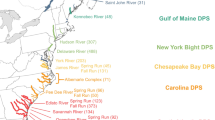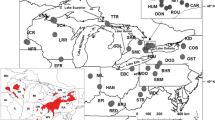Abstract
The anadromous Atlantic sturgeon Acipenser oxyrinchus oxyrinchus, a wide-ranging species along the Atlantic Coast of North America, is being considered for federal listing under the U.S. Endangered Species Act. Identification of distinct population segments (DPS) is necessary but problematic for highly vagile species such as Atlantic sturgeon which may spend a high proportion of their lives outside of their natal estuaries. Characterization of genetic differentiation and estimates of gene flow provide a quantitative measure of the number of DPS into which species could be divided over their distribution and the reproductive independence of each unit. We sequenced a portion of the mitochondrial DNA control region to characterize population structure and gene flow across all naturally reproducing populations from which specimens could be obtained. We then considered these genetic data along with ancillary information on life history characteristics, historical fisheries data, and trajectories of abundance to determine the number of DPS into which this species should be divided. Our results suggest that philopatry is high for Atlantic sturgeon and that each U.S. estuary analyzed hosts genetically distinct populations of Atlantic sturgeon. We conclude that at least nine DPS of Atlantic sturgeon exist along the Atlantic Coast of the U.S. In contrast, the Atlantic Sturgeon Status Review Team has proposed a five DPS scheme for this subspecies based largely on results from nuclear DNA microsatellites, but with fewer populations represented and lower samples sizes. These different conclusions illustrate the somewhat arbitrary nature of the DPS concept, at least as applied to Atlantic sturgeon.



Similar content being viewed by others
References
ASSRT (Atlantic Sturgeon Status Review Team) (2007) Status review of Atlantic sturgeon (Acipenser oxyrinchus oxyrinchus). Report to the National Marine Fisheries Service, Northeast Regional Office, Gloucester, MA, pp 187
Bain MB, Peterson DL, Arend KK, Haley N (1999) Atlantic sturgeon population monitoring for the Hudson River Estuary: sampling design and gear recommendations. Final Report to the Hudson River Fisheries Unit, New York State Department of Environmental Conservation, New Paltz
Berg LS (1959) Vernal and hiemal races among anadromous fishes. J Fish Res Bd Canada 16:515–537
Bonin A, Nicole F, Popanon F, Miaud C, Taberlet P (2007) Population adaptive index: a new method to help measure intraspecific genetic diversity and prioritize populations for conservation. Cons Biol 21:697–708
Clement M, Posada D, Crandall KA (2000) TCS: a computer program to estimate gene geneaologies. Mol Ecol 9:1657–1659
Collins R, Rogers SG, Smith TIJ (1996) Bycatch of sturgeons along the Southern Atlantic Coast of the USA. N Am J Fish Manage 16:24–29
Dovel WL, Berggren TJ (1983) Atlantic sturgeon of the Hudson River Estuary, New York. NY Fish Game J 30:140–172
Excoffier L, Laval G, Schneider S (2005) Arlequin ver. 3.1: an integrated software package for population genetic analysis. Evol Bioinform Online 1:47–50
Felsenstein J (1985) Confidence limits on phylogenies: an approach using bootstrap. Evolution 39:783–791
Fraser DJ, Bernatchez L (2001) Adaptive evolutionary conservation: towards a unified concept for defining conservation units. Mol Ecol 10:2741–2752
Fu Y-X (1997) Statistical tests of neutrality against population growth, hitchhiking and background selection. Genetics 143:557–570
Green DM (2005) Designatable units for status assessment of endangered species. Conserv Biol 19:1813–1820
Grogan CS, Boreman J (1998) Estimating the probability that historical populations of fish species are extirpated. N Am J Fish Manage 18:522–529
Hatin D, Fortin R, Caron F (2002) Movement and aggregation areas of adult Atlantic sturgeon (Acipenser oxyrinchus) in the St. Lawrence River estuary, Quebec, Canada. J Appl Ichthyol 18:586–594
Hudson RR, Slatkin M, Maddison WP (1992) Estimation of levels of gene flow from DNA sequence data. Genetics 132:583–589
King TL, Lubinski BA, Spidle AP (2001) Microsatellite DNA variation in Atlantic sturgeon (Acipenser oxyrinchus oxyrinchus) and cross-species amplification in the Acipenseridae. Conserv Genet 2:103–119
Lee DS, Gilbert CR, Hocutt CH, Jenkins RE, McAllister DE, Stauffer JR Jr (1980) Atlas of North American freshwater fishes. North Carolina State Museum of Natural History, Raleigh
Ludwig A, Debus L, Lieckfeldt D, Wirgin I, Benecke N, Jenneckens I, Williot P, Waldman JR, Pitra C (2002) When the American Atlantic sturgeon went East. Nature 419:448–449
Mangin E (1964) Croissance en longueur de trois esturgeons d’Amerique du Nord: Acipenser oxyrhynchus, Mitchill, Acipenser fulvescens, Rafinesque, et Acipenser brevirostris LeSueur. Verh Int Ver Limnol 15:968–974
Mantel N (1967) The detection of disease clustering and generalized regression approach. Cancer Res 27:209–220
McElroy D, Moran P, Bermingham E, Kornfield I (1992) REAP: an integrated environment for the manipulation of and phylogenetic analysis of restriction data. J Hered 83:157–158
Miller MP (1997) Tools for population genetic analyses (TFPGA) 1.3; A Windows program for the analysis of allozyme and molecular population genetic data
Nei M (1972) Genetic distances between populations. Am Nat 106:283–292
Nei M (1978) Estimation of average heterozygosity and genetic distance from a small number of individuals. Genetics 89:583–590
Nei M (1987) Molecular evolutionary genetics. Columbia University Press, New York
Nielsen R, Wakeley J (2001) Distinguishing migration from isolation: a Markov Chain Monte Carlo approach. Genetics 158:885–896
Ong T-L, Stabile J, Waldman JR, Wirgin I (1996) Genetic divergence of Atlantic and Gulf of Mexico sturgeon based on sequence analysis of the mtDNA control region. Copeia 1996:464–469
Palsboll PJ, Berube M, Allendorf FW (2006) Identification of management units using population genetic data. Trends Ecol Evol 22:11–16
Peterson DL, Bain MB, Haley N (2000) Evidence of declining recruitment of Atlantic sturgeon in the Hudson River. N Am J Fish Manage 20:231–238
Peterson DL, Schueller P, Fleming J, Grunwald C, Wirgin I (in Press) Biological characteristics and critical habitats of Atlantic sturgeon in the Altamaha River, Georgia. Trans Am Fish Soc
Pikitch EK, Doukakis P, Lauck L, Chakrabarty P, Erickson DL (2005) Status, trends and management of sturgeon and paddlefish fisheries. Fish Fish 6:233–265
Roff DA, Bentzen P (1989) The statistical analysis of mitochondrial DNA polymorphisms: Χ2 and the problem of small samples. Mol Biol Evol 6:539–545
Saghai-Maroof MA, Soliman KM, Jorgneson RA, Allard RW (1984) Ribosomal DNA spacer-length polymorphisms in barley: Mendelian inheritance, chromosomal location, and population dynamics. Proc Nat Acad Sci USA 81:8014–8018
Secor DH (2002) Atlantic sturgeon fisheries and stock abundances during the late nineteenth century. Am Fish Soc Symp 28:89–98
Secor DH, Waldman JR (1999) Historical abundance of Delaware Bay Atlantic sturgeon and potential rate of recovery. Am Fish Soc Symp 23:203–216
Shirey CA, Martin AC, Stetzar EJ (1999) Atlantic sturgeon abundance and movement in the lower Delaware River. Final Report. NOAA Project No. AGC-9N. Grant No. A86FA0315. Delaware Division of Fish and Wildlife, Dover
Smith TIJ (1985) The fishery, biology, and management of Atlantic sturgeon, Acipenser oxyrhynchus, in North America. Environ Biol Fishes 14:61–72
Status Review of Atlantic sturgeon (Acipenser oxyrinchus oxyrinchus) September 1998
Stein AB, Friedland KD, Sutherland M (2004a) Atlantic sturgeon marine bycatch and mortality on the continental shelf of the northeast United States. N Am J Fish Manage 24:171–183
Stein AB, Friedland KD, Sutherland M (2004b) Atlantic sturgeon marine distribution and habitat use along the northeastern coast of the United States. Trans Am Fish Soc 133:527–537
Sweka JA, Mohler J, Millard MJ, Kehler T, Kahnle A, Hattala K, Kenney G, Higgs A (in Press) Juvenile Atlantic sturgeon habitat use in Newburgh and Haverstraw Bays of the Hudson River: Implications for population monitoring. N Am J Fish Manage
Tajima F (1989) Statistical method for testing the neutral mutation hypothesis by DNA polymorphism. Genetics 123:585–595
Tajima F (1993) Measurement of DNA polymorphism. In: Takahata N, Clark GA (eds) Mechanisms of molecular evolution. Introduction to molecular paleopopulation biology. Japan Scientific Societies Press, Sinaur Associates, Inc., Sunderland, MA
Taub SH (1990) Fishery management plan for Atlantic sturgeon (Acipenser oxyrhynchus). Fisheries Management Report No. 17 of Atlantic States Marine Fisheries Commission. pp 73
Tiedemann R, Moll K, Paulus KB, Scheer M, Williot P, Bartel R, Gessner J, Kirschbaum F (2007) Atlantic sturgeons (Acipenser sturio, Acipenser oxyrinchus): American females successful in Europe. Naturwissenschaften 94:213–217
Waldman JR, Grunwald C, Stabile J, Wirgin I (2002) Impacts of life history and biogeography on genetic stock structure in Atlantic sturgeon, Acipenser oxyrinchus oxyrinchus, Gulf sturgeon A. oxyrinchus desotoi, and shortnose sturgeon, A. brevirostrum. J Appl Ichthyol 18:509–518
Waldman JR, Hart J, Wirgin I (1996) Stock composition of the New York Bight Atlantic sturgeon fishery based on analysis of mitochondrial DNA. Trans Am Fish Soc 125:364–371
Waldman JR, Wirgin II (1998) Status and restoration options for Atlantic sturgeon in North America. Atlantic sturgeon in North America: status and restoration options. Conserv Biol 12:631–638
Waples RS (1991) Pacific salmon, Oncorhynchus spp., and the definition of “species” under the Endangered Species Act. Mar Fish Rev 53:11–22
Weir BS, Cockerham CC (1984) Estimating F-statistics for the analysis of population structure. Evolution 38:1358–1370
Wirgin II, Waldman JR, Rosko JR, Gross R, Collins MR, Rogers SG, Stabile J (2000) Genetic structure of Atlantic sturgeon populations based on mitochondrial DNA control region sequences. Trans Am Fish Soc 129:476–486
Wirgin I, Grunwald C, Waldman JR, Stabile J (2007) Genetic evidence for relict Atlantic sturgeon stocks along the mid-Atlantic coast of the USA. N Am J Fish Manage 27 (in press)
Wright (1951) The genetical structure of populations. Ann Eugen 15:323–354
Acknowledgments
We thank D. Gorham, T. Squiers, S. Nack, G. Murphy, C. Shirey, D. Fox, K. Place, C. Hager, A. Spells, J. Armstrong, J. Hightower, M. Collins, B. Post, J. Fleming, W. Weber, G. Rogers, and D. Peterson for providing the tissue samples analyzed in this study and M. Hickerson for reviewing the manuscript. We also acknowledge support of the Protected Species Division of NMFS, Gloucester, MA, for support of this study, Julie Carter of the NOS/National Centers for Coastal Ocean Science, Marine Forensics Archive for providing archived tissue samples, and the Molecular Facility Core of the NYU NIEHS Center ES00260 for the use of its shared instrumentation.
Author information
Authors and Affiliations
Corresponding author
Rights and permissions
About this article
Cite this article
Grunwald, C., Maceda, L., Waldman, J. et al. Conservation of Atlantic sturgeon Acipenser oxyrinchus oxyrinchus: delineation of stock structure and distinct population segments. Conserv Genet 9, 1111–1124 (2008). https://doi.org/10.1007/s10592-007-9420-1
Received:
Accepted:
Published:
Issue Date:
DOI: https://doi.org/10.1007/s10592-007-9420-1




